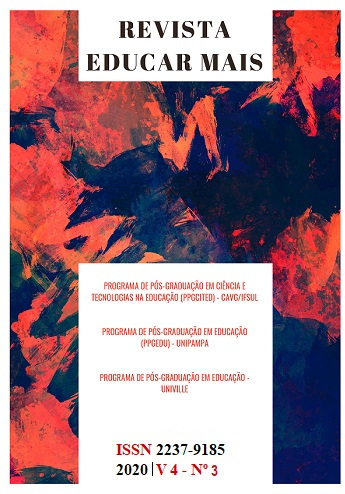The teaching of the discipline of Architectural Design aided by augmented reality
DOI:
https://doi.org/10.15536/reducarmais.4.2020.2014Keywords:
Teaching-learning; Architectural project; Augmented reality.Abstract
ABSTRACT
Technological resources are increasingly adopted within the school, replacing traditional slates. Multimedia projectors, as an example, bring with them an easy presentation of textual elements and videos, thus enhancing the teaching and learning field in the school institution. The purpose of this article is to address the use of technology known as Augmented Reality (AR) so that the instruction of the architectural design discipline is built more efficiently. This proposal aims to remedy a collective difficulty in visualizing three-dimensional architectural elements represented in two-dimensional design. The methodology used is characterized as qualitative, as well as exploratory and descriptive, through an experiment with a three-dimensional building and its architectural project with students of the Technical Course in Buildings offered by the Federal Institute of Education, Science and Technology of Ceará (IFCE) Morada Nova campus. Such research was approved by the Ethics and Research Committee of IFCE itself, an interdisciplinary collegiate body and independent in its performance and decisions within its competence. The results obtained through the use indicate that the use of AR increases learning in this area, requiring only the use of a smartphone with simple configurations and internet access, so that the applicability of AR is viable.
Downloads
References
ANDRADE, A. P. R. Uso das tecnologias na educação: computador e internet. 2011. 22 f. Trabalho de Conclusão de Curso (Licenciatura em Biologia) - Universidade Estadual de Goiás, Brasília, 2011. Disponível em: https://bdm.unb.br/bitstream/10483/1770/1/2011_AnaPaulaRochadeAndrade.pdf. Acesso em: 08/09/2020.
AZUMA et al. (2001). Recent advances in augmented reality. IEEE computer graphics and applications, Áustria, v. 21, n. 6, p. 34-47, Nov/Dez. 2001. Disponível em: https://ieeexplore.ieee.org/abstract/document/963459. Acesso em: 08/09/2020.
BUENO, N. O desafio da formação do educador para o ensino fundamental no contexto da educação tecnológica. 1999. 16f. Revista Ibero-americana de Estudos em Educação – Universidad de Alcalá, Madri, Espanha, 1999.
CORTELLA, M. S. Educação, escola e docência: Novos tempos, novas atitudes. São Paulo: Cortez, 2014.
DEMO, P. Pedro Demo aborda os desafios da linguagem no século XXI, In: BRASIL. Ministério da Educação. Secretaria de educação à Distância. Tecnologias na Educação: ensinando e aprendendo com as TIC. Brasília: 2008. Disponível em: / Acesso em: 07/09/2020.
GABRIEL, M. Educ@r - A (r)evolução Digital na Educação. 1. ed. São Paulo: Saraiva, 2013.
KURUMAN, G.; SANTHI, K. R.; ANAND, P. M. Impact of Augmented Reality (AR) in civil engineering. Advanced Materials Research, v. 18–19, Jan/2007. Disponível em: https://www.researchgate.net/publication/250355839_Impact_of_Augmented_Reality_AR_in_Civil_Engineering. Acesso em: 08/09/2020.
MENDONÇA, R. L.; MUSTARO, P. N. Como tornar aplicações de realidade virtual e aumentada, ambientes virtuais e sistemas de realidade mista mais imersivos. In: SYMPOSIUM ON VIRTUAL AND AUGMENTED REALITY, 13, 2011, Uberlândia/MG. Minas Gerais: SBC, 2011.
MILGRAM, P et al. Augmented Reality: A Class of Displays on the RealityVirtuality Continuum. Society of Photo-optical Instrumentation Engineers, v. 2351, jan/1994. Disponível em: https://www.researchgate.net/publication/228537162_Augmented_reality_A_class_of_displays_on_the_reality-virtuality_continuum. Acesso em: 10/09/2020.
MORÁN, J. Mudando a educação com metodologias ativas. Convergências Midiáticas, Educação e Cidadania: aproximações jovens. SOUZA, C. A.; MORALES, O. E T (org.). Ponta Grossa: UEPG/PROEX, 2015. Disponível em: https://www.ucs.br/site/midia/arquivos/bibliografia-PGCIMA-canela.pdf. Acesso em: 10/09/2020.
SÁ, A et al. Augmented reality to aid construction management. Cmne/Cilamce, n. 13–15, jun/2007. Disponível em: https://www.researchgate.net/profile/Alberto_Raposo/publication/228612181_Augmented_reality_to_Aid_Construction_Management/links/0fcfd50bfa77417887000000.pdf. Acesso em: 08/09/2020.
SILVA, T. T. Documentos de identidade: uma introdução às teorias do currículo. 2. ed. 2. reimp. Belo Horizonte: Autêntica, 2001.
THORNTON, T.; ERNST, J. V.; CLARK, A. C. Augmented reality as a visual and spatial learning tool in technology education. Technology & Engineering Teacher, v. 71, n. 8, p.18-21, Maio/Jun 2012. Disponível em: http://migre.me/dtrE3. Acesso em: 10/09/2020.
TORI, R; KIRNER, C. Fundamentos de realidade virtual. In: TORI, R; KIRNER, C; SISCOUTO, R. (Org). Fundamentos e tecnologia de realidade virtual e aumentada. Porto Alegre: Sociedade Brasileira de Computação, p.9-28. 2006
TORI, R.; HOUNSELL, M. S. (org.). Introdução a Realidade Virtual e Aumentada. Porto Alegre: Editora SBC, 2018. Disponível em: http://www.de.ufpb.br/~labteve/publi/2018_livroRVA.pdf. Acesso em: 10/09/2020.
ZEVI, B. A linguagem Moderna da Arquitetura. Lisboa: Publicações Dom Quixote,1984.
Downloads
Published
How to Cite
Issue
Section
License
Copyright (c) 2020 Jonathan Felipe da Silva, Jefferson Queiroz Lima, Sandro César Silveira Jucá, Adriano Bayma de Mesquita, Aldayr de Oliveira Monteiro

This work is licensed under a Creative Commons Attribution-NonCommercial 4.0 International License.
DECLARATION OF RESPONSIBILITY: I hereby certify that I partially or fully participated in the conception of the work, that I did not hide any links or financial agreements between the authors and companies that may be interested in this article publication. I certify that the text is original and that the work, partially or fully, or any other work with a substantially similar content written by me, was not sent to any other journal and it will not be send while my submission is being considered by Revista Educar Mais, whether in printed or electronic format.
The author responsible for the submission represents all the authors of the manuscript and, when sending the article to the journal, guarantees s/he has obtained the permission to do so, as well as s/he guarantees the article does not infringe upon anyone’s copyright nor violate any proprietary rights. The journal is not responsible for the opinions expressed.
Revista Educar Mais is Open Access, does not charge any fees, whether for submission or article processing. The journal adopts Budapest Open Access Initiative (BOAI)’s definition, i.e., any users are permitted to read, download, copy, distribute, print, search and link to the full texts of these articles.
All the articles are published under the Creative Commons Atribuição-NãoComercial 4.0 Internacional license. The authors keep the copyright of their production. That way, they must be contacted directly if there is any interest in commercial use of their work.
















